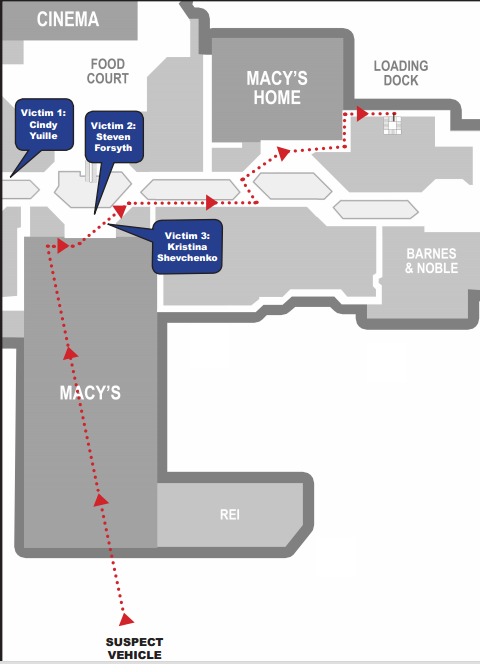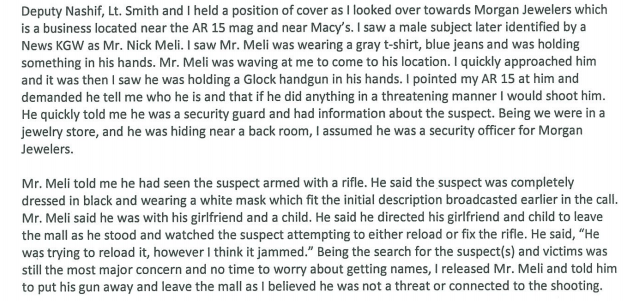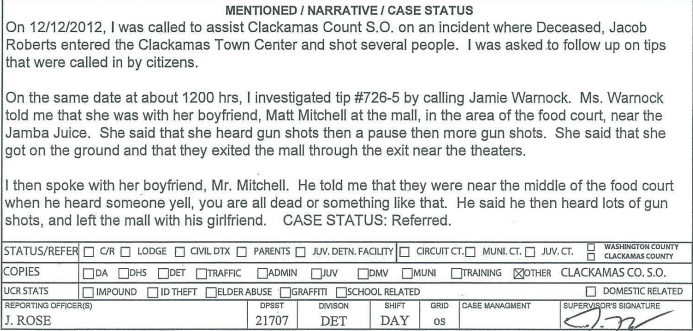The never ending gunfire that may not warm the heart
 For those who were at Clackamas Town Center on the afternoon of December 11, 2012, the sounds of gunfire still rings clearly this holiday. They will tell you that on that day each shot fired by 19 year old Jacob Roberts had a meaning all of its own. They wondered, not in awe but in fear, that each round of ammunition carried name of a potential victim ,theirs, at the end of its travel. They know exactly where they were when the shooting started, but will be hard pressed to tell you when it stopped. Because it never seemed to stop that afternoon. For some it still has not stopped. For others and their families it will never stop.
For those who were at Clackamas Town Center on the afternoon of December 11, 2012, the sounds of gunfire still rings clearly this holiday. They will tell you that on that day each shot fired by 19 year old Jacob Roberts had a meaning all of its own. They wondered, not in awe but in fear, that each round of ammunition carried name of a potential victim ,theirs, at the end of its travel. They know exactly where they were when the shooting started, but will be hard pressed to tell you when it stopped. Because it never seemed to stop that afternoon. For some it still has not stopped. For others and their families it will never stop.
Lost in the gunfire that day was one simple fact: The cops were on the way with an energy and commitment to duty you can only understand if you have been there. There was no illusion for those deputies and police officers that they were riding to the rescue of those in trouble. They knew that the report of gunfire meant that they were on the way not to save every life but, if they were lucky and skilled, the next one. That the gunfire was happening in a place where violence can multiply its affect quickly only meant that once on scene they would not have time try to find “a safe way” to stop the shooting. It didn’t matter who or what awaited them either outside or inside. The only mission regardless of the danger of the unknown was to stop the shooting and stop it in the soonest moment possible.
In the background, invisible to all except Operations, was the command brain center that guided the operations through the eyes and ears of cops about to be deployed around and then into Clackamas Town Center. Tactical Command is the place where the command to act is guided through the careful assessment of the situation as relayed by the sights and sounds being soaked in by the cops on scene. Tactical command is the place where fear and the strong sense of duty takes a deep breath, and, in this case, where rational and unemotional decisions were made and then implemented.
 It is the place where a commander’s career experience brings life to a life and death plan where there are significantly more unknowns than certainties. The clear separation of Tactical Command and Operational Command both in location and mind set was beyond essential, it is in fact critical to the life and death decisions and action that followed. The separation of Tactical and Operational Command signaled a well trained and disciplined police response. Clearly the decisions made were based on well tested police policy and implemented by a calm deployment of operations resources.
It is the place where a commander’s career experience brings life to a life and death plan where there are significantly more unknowns than certainties. The clear separation of Tactical Command and Operational Command both in location and mind set was beyond essential, it is in fact critical to the life and death decisions and action that followed. The separation of Tactical and Operational Command signaled a well trained and disciplined police response. Clearly the decisions made were based on well tested police policy and implemented by a calm deployment of operations resources.
When Operations Command and Tactical Command were joined in purpose at Town Center, tactical Command asking the right question in the right order was more important than any singular answer to follow by Operational Command. Soon that would flip over and the observations of Operational Command would be driving the plan now being formulated, deployed and revised in the minds of the Tactical Commander. That is correct commander singular. A heavy burden to shoulder. Orders given from Tactical Command will be responsible for the lives yet to enter the mall and those waiting to be rescued. Calculating a tactical plan does not mean delaying operational action. It only means that tactical guidance must be an unemotional decision making process and the resulting guidance implemented rationally by operations command.
So as the cops began to arrive they prepared a mental checklist of what they would be facing. When two, three, four uniforms arrived from whatever agency, they knew that waiting for a Special Weapons Team was not an option. They gathered and deployed into the mall with the unknowns far out weighing any certainties. They may or may not have comparable firepower as a group or as individuals. They used their “Active Shooter” training which sent them in to hunt down the bad guys and neutralizing them. They knew there was much more danger to those waiting for their help. The safety of the Active Shooter team they knew would have to wait. But they did not engage this shooter. Roberts shot himself when his delusion meets reality.
For Cindy Yuille and Steven Forsythe the best tactical plan backed up by the courage to actively hunting the shooter would come too late. For Kristina Shevechenko the presence of well trained operational deputies and police officers could no doubt only provide emergency attention to her critical wounds and does very little to give her emotional comfort going forward. For their families all that tactical and operational mumbo jumbo matter little. They will find whatever peace comes to them in the memory of Cindy and Steven and grateful for the recovery of Kristina.
A year later we are still arguing over whether the actions of an armed, licensed security guard, Nick Meli, who said he drew his weapon to engage Roberts himself really made any difference. We are still trying to assess the possibility that Roberts seeing Meli’s gun caused him to end the shooting. In the moment it may have, we will never know, but in the longer threat assessment to our community, I’m not sure it does.

In all the recounting of the tragedy at Town Center, the evil of guns in the wrong hands remains front and center. The problem is we can’t define the “wrong hands” let alone the wrong gun. If it is not all guns that are evil then certainly we are still in a free fire zone conversation regarding the killing power of high capacity weapons and ammunition magazines. But we are still no closer to placing responsibility with those who harbor guns legally but carelessly.
In all the review of the Clackamas Town Center shootings this month you will find no mention of how the AR-15 used in the shooting got into the hands of this violence prone individual. To refresh memory, Roberts took the weapon from a friend’s house in the hours prior to his delusional rampage. I use the word “took” because it must not have been stolen. He must have allowed Roberts to possess the gun otherwise a responsible gun owner would have reported the weapon stolen maybe even naming Roberts as a suspect. The only other possibility is that he had no idea the AR-15 was missing and even where it might have been at any one moment, even that moment when it was blazing terror into Clackamas Town Center. We can be absolutely sure that it was not locked away in a place not available to any other person including Jacob Roberts.

Our law makers must place the responsibility squarely on the owner to secure this gun. There is a legitimate state interest of the state to control firearms through forcing individual responsibility of ownership even of just high capacity firearms and magazines with appropriate penalty assigned when the statutory test is failed to be met. if they need further proof just ask the parents and families of 20 children and 6 teachers and staff of Newtown Connecticut who were shot to death by Adam Lanza who was armed firearms legally purchased by his mother and left available to him even with known mental health issues. Again: no unsecured guns, very likely no shooter.
If we quit quibbling over tired gun purchase issues and– just for this holiday season– remember the shots fired at Clackamas Town Center and that preventing this shooting before it happened may have been within control of our well intended political leaders. Certainly the next time they can’t say they didn’t know.
And the best news is that it will take very little political courage.
Now there is a heartwarming thought
Bernie Giusto is the retired Multnomah County Sheriff, former Gresham Police Chief, former Gresham city council member, and member of the Multnomah County ESD. He’s also a member of the Victoria Taft Blogforce.



